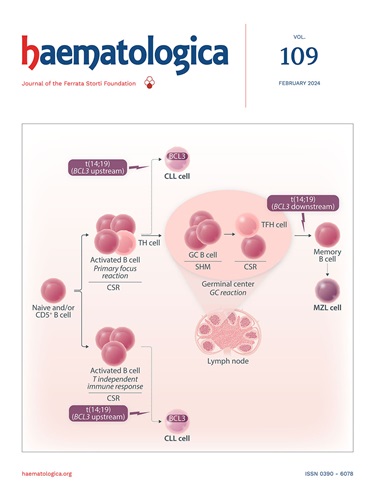谱系不明的急性白血病:已知的和不确定的。
IF 7.9
1区 医学
Q1 HEMATOLOGY
引用次数: 0
摘要
不明谱系急性白血病(ALAL)是一种罕见的、高风险的急性白血病。它的特点是不能将单一的分化谱系分配给白血病,并且可以表现为多个谱系定义标记,称为混合表型急性白血病(MPAL),或者完全没有这些标记,定义为急性未分化白血病(AUL)。最近对遗传、表观遗传和代谢的研究改进了诊断框架,为分类和风险分层提供了信息,并暴露了潜在的目标漏洞。然而,ALAL的罕见性和异质性表现导致诊断和治疗的不确定性。最近的世界卫生组织(WHO)和国际共识分类(ICC)手稿提供了一个实用的框架,整合了免疫表型和遗传分类标准,并承认了定义疾病生物学的特定体细胞遗传改变。这些包括涉及BCR::ABL1、KMT2A、ZNF384和BCL11B激活的重排。目前的证据支持使用all型诱导方案(对philadelphia阳性MPAL添加酪氨酸激酶抑制剂(TKI))治疗AML或混合方法。对于AUL,最佳治疗方法尚不确定。基于ALAL特定的生物学和遗传特征,结合靶向治疗与强化和低强度化疗是一种有吸引力的方法,并且越来越多地被报道。在具有多表型潜力的急性白血病患者中,使用谱系特异性靶向方法可能会导致治疗压力和谱系切换。由于缺乏前瞻性对照数据,最小残留疾病监测在ALAL中指导治疗和告知移植的作用和最佳平台尚不清楚。本文章由计算机程序翻译,如有差异,请以英文原文为准。
Acute leukemia of ambiguous lineage: the known and the uncertain.
Acute leukemia of ambiguous lineage (ALAL) is a rare, high-risk form of acute leukemia. It is characterized by the inability to assign a single lineage of differentiation to the leukemia and can manifest with more than one lineage-defining marker, called mixed phenotype acute leukemia (MPAL), or the complete absence of such markers, defined as acute undifferentiated leukemia (AUL). Recent genetic, epigenetic and metabolic insights refine diagnostic frameworks, inform classification and risk-stratification, and expose potential targetable vulnerabilities. However, the rarity and heterogeneous manifestations of ALAL result in ongoing diagnostic and therapeutic uncertainty. The most recent World Health Organization (WHO) and International Consensus Classification (ICC) manuscripts provide a pragmatic framework integrating immunophenotypic and genetic criteria for classification, with recognition of specific somatic genetic alterations that define disease biology. These include rearrangements involving BCR::ABL1, KMT2A, ZNF384, and BCL11B activation. Current evidence supports the use of ALL-type induction regimens (with the addition of tyrosine kinase inhibitors (TKI) for Philadelphia-positive MPAL) over AML or hybrid approaches. For AUL the optimal therapeutic approach is uncertain. Incorporation of targeted therapies in combination with intensive, and lower-intensity chemotherapy backbones based on the specific biological and genetic characteristics of ALAL is an appealing approach and is increasingly reported. The use of lineage-specific targeted approaches may result in therapeutic pressure and lineage switch in patients with acute leukaemia with multi-phenotypic potential. The role and optimal platform for minimal residual disease surveillance in ALAL to guide therapy, and inform transplantation is unclear, given the paucity of prospective controlled data.
求助全文
通过发布文献求助,成功后即可免费获取论文全文。
去求助
来源期刊

Haematologica
医学-血液学
CiteScore
14.10
自引率
2.00%
发文量
349
审稿时长
3-6 weeks
期刊介绍:
Haematologica is a journal that publishes articles within the broad field of hematology. It reports on novel findings in basic, clinical, and translational research.
Scope:
The scope of the journal includes reporting novel research results that:
Have a significant impact on understanding normal hematology or the development of hematological diseases.
Are likely to bring important changes to the diagnosis or treatment of hematological diseases.
 求助内容:
求助内容: 应助结果提醒方式:
应助结果提醒方式:


